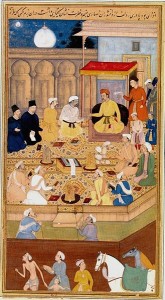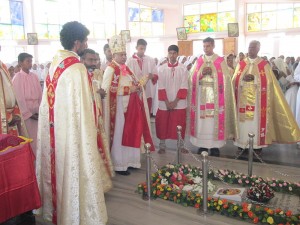Introduction

Christians constitute the second largest religious minority in India next to Islam. The roughly 28 million Christians in India account for 2.3 percent of the total population. With 17 million or so adherents to the faith, Roman Catholics form the largest single Christian group in India. There are approximately 45 million adherents to different denominations of the Protestant faith (Europa 1740). The heaviest concentration of Christians is in the state of Kerala, which is one of the oldest Christian communities in the world.
A Brief History
Due to the lack of documentary evidence, the origin of Christianity in India has been the subject of controversy among historians. According to tradition and legend, Apostle Thomas went west to India and started the church in A.D. 52. Following established trade routes, he converted many to Christianity, including members of the royal family (Mundadan 25). Following his example, many other foreign missionaries made numerous converts to Christianity.
In the 16th century, Jesuit Saint Francis Xavier expanded the Christian community westward evangelizing to those from the lower caste and outcastes. The ideals of humility and the rejection of worldly possession associated with Christianity appealed to the early Christians. Christianity was thought of as “the religion of the poor” (Kooliman 102) (see Spice Trade in India).
Beginning in the eighteenth century, Protestant missionaries began to work throughout India that lead to the growth of Christian communities (Bogard; Mayhew 47). “These new Christians were almost exclusively recruited from the poorest and most degraded sections of society” (Kooliman 5).
Trade and Christianity
The insatiable interest in India began with business conducted by the East India Trading Company. Dealing with more than mere trading concerns, the trading company became a ruling power in India. From 1770-1818, “through wars and annexations almost three fourth of India was to come under the control of the Company” (Pathak 3). Interestingly, many of the Christians of St. Thomas harvested pepper. “Pepper growing was almost their sole monopoly” (Mundadan 155). The members of the church grew most of the pepper that was exported to Portugal.
Difficulties of the Christian Mission in India
One of the gravest problems facing Christianity in India is the problem of adaptation. Despite Hindu willingness to adapt Christianity into their religious system, Christians have encountered difficulties with Indians unwilling to compromise their own beliefs. Many Indians refused to believe in the absolutism of Christian theology. The doctrine of Christianity that was most problematic was the proclamation of Christianity as the only true religion, viewing it as a manifestation of the hated colonialism (see Cecil Rhodes, Victorian Women Travelers in the 19th Century). The assimilation of Christianity into the Indian population required an incorporation of Christianity within the regimes of Indian culture. For this same reason, “Indian Christians have Indianized their churches and tried to end their dependence on foreign missions” (Borgard). An example of the challenges in India manifests with the treatment of traditional clothing. In a culture where clothing represents social status, one of the most evident forms of discrimination forbade the people of the lower caste to cover the upper part of the body. A bare breast was seen as a sign of respect to those considered to be higher status (Kooliman 148-49). In reaction to the custom, the missionary ladies implemented a jacket (ravakkay) to cover up the upper portion of the body. However, it did not meet the standards of the Christian Indians. Sparking waves of violence between the castes, in 1814, a proclamation was given permitting Christian Indian women to cover their bosom, but not in a manner identical to the women of the higher caste. In addition, the proclamation stated, women of the lower caste were not permitted “to act towards persons of higher caste contrary to the usages of their own caste before they [became] Christians” (Kooliman 150).
Impact of Christianity on Hinduism
One of the biggest projects of the Christians missions was to educate. The goals of the missions included “education of all kinds and grades, among their instruments for the evangelization of India” (Mayhew 161). Success of the colonization largely depended on the “enlightenment of India by Christian secondary schools and colleges” (Mayhew 161). The British Government provided most of the funding. However, the inherent combination of Christianity and education derived from Western civilization jeopardized the government’s stance of religious neutrality.
Important Figures of Christianity in India

Ram Mohan Roy (1772-1833), the “father of modern India,” was an important Hindu leader who assimilated Christian ideals and ethics to reform the social abuses of India. He “renounced idolatry at the age of sixteen” and “devoted himself to the study of the Bible in Hebrew and Greek” (Mayhew 171). He did not accept the divinity of Christ, but was “strongly attracted to the personality of Christ and to his moral teachings.” He improved the moral and social conditions of India. He started the Brahmo Samaj (City of God) by conducting weekly meeting to incorporate Christian ethics with the best of Hinduism. What they saw as the best parts of Christianity were worshipping God by love and good deeds, and abstinence from idolatry (Boygard).
One of the most successful leaders in religious conversions from Hinduism to Christianity was native Indian, Vedanayagam Samuel Azariah. “He was the first and only native Indian bishop of an Anglican diocese from 1912 until his death in 1945″ (Harper 1). With the large responsibilities of being in charge of all Anglican missions came difficulties within the internal community of the church. Many felt that “the consecration was fueling destructive Indian ambitions and signaled a dangerous change in status between Indian And European Christians” (Harper 227). Dealing with language, culture, and different denominations, he embodied the conflicts and challenges of both Christian evangelism and British rule. He also bridged the differences between ordinary Indians and British elite during the turbulent period of the imperial associations. Azariah is known to be someone would not compromise the doctrines of Christianity and Indian culture.
Christianity Today
Despite the waves of missionaries to India under colonial rule, the number of Christians in India remains small, especially in comparison to the total Indian population of 846,302,688 (Europa 1726). In 1947 and 1970, the creation of the Church of South India and Church of North India decreased the affiliations among Protestant churches. However, representations of small fundamentalist sects still exist throughout India creating a kaleidoscopic conglomeration of peoples, languages, cultures, perspectives, theologies and practices. Christians and churches relate to surrounding society in vastly differing ways, from being a dominant force in Kerala, a significant influence in other southern and northeastern states, to a desperately weak minority in the main body of India (Europa 1740).
See Also The Moor’s Last Sigh.
Works Cited
- Bogard, Medina. “Indian Religion.” 1 May 1997. Southern Nazarine University. 10 November 2000. Web.
- “Christianity in India.” Encyclopedia Britanica Online. 11 November 2000. Web. <http://www.britannica.com/EBchecked/topic/285248/India>
- Harper, Susan Billington. In the Shadow of the Mahatma: Bishop V.S. Azariah and the Travails of Christianity in British India. Ed. Kevin Ward and Brian Stanley. Grand Rapids: Eerdmans Publishing, 2000.
- Kooliman, Dick. Conversion and Social Equality in India. New Delhi: South Asia Publications, 1983.
- Mayhew, Arthur. Christianity in India. Delhi: Gian Publishing House, 1998.
- Mundadan, A. Mathias. History of Christianity in India. vol. 1. Bangalore: Theological Publications, 1984.
- Pathak, Sushil Madhav. American Missionaries and Hinduism. Delhi: Oriental Publishers, 1967.
Author: Sarah Park, Fall 2000
Last edited: October 2017
2 Comments
Good evening. Under the heading “Trade and Christianity” the second sentence reads, “Dealing with more then mere trading concerns…” Clearly “then” should be amended to read “than.” Best wishes!
Thank you, Dr. Faber! I have made the edit and updated the post! Kind regards, Caroline Schwenz